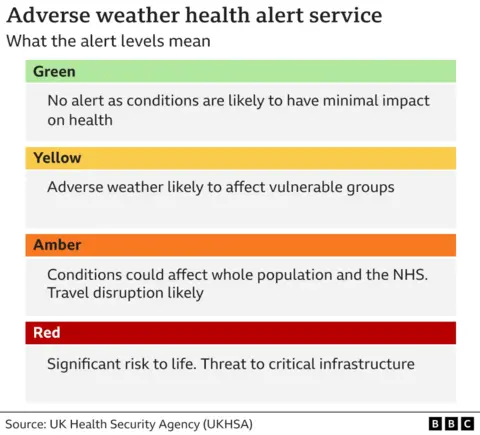By Ben Rich, BBC Weather • Lipika Pelham, BBC News
 Getty Images
Getty ImagesYellow heat-health alerts will be in place for most of England this week, as daytime temperatures look set to reach 30C (86F).
The alerts from the UK Health Security Agency (UKHSA) come into force at 08:00 BST on Monday and remain in place in eight regions until Thursday afternoon.
A yellow warning indicates that weather conditions could pose a risk to those who are particularly vulnerable.
The UKHSA says minor impacts are probable across the health and social care sector.
What is the latest weather forecast?
The next few days are expected to bring the highest temperatures of the summer so far as warm air surges northwards across the UK.
Scotland and Northern Ireland are expected to see their warmest weather on Monday, with highs of 24 to 26C, before cloudier and cooler weather arrives from the west on Tuesday.
But in England and Wales the heat is expected to be longer-lasting, with midweek temperatures of 28 or 29C likely in the South East – accompanied by plenty of strong sunshine.
It is possible that some areas might reach the Met Office’s official heatwave criteria. The nights will also be warmer and more humid than we have been used to lately.
The weather is expected to turn cooler and wetter by the end of the week but there is considerable uncertainty about how quickly that change will take place.
If you are making plans further ahead, including for Glastonbury, it is worth staying up-to-date with BBC Weather over the coming days.
Where are the latest heat-health alerts?
 UKHSA
UKHSAYellow heat-health alerts will be active from 08:00 on Monday 24 June in eight regions of England:
- East Midlands
- West Midlands
- the North West
- the South East
- the South West
- the East of England
- London
- Yorkshire and the Humber
The North East is not affected.
The alerts will remain in place until 17:00 on Thursday 27 June.
The weather is expected to turn cooler, cloudier and wetter by the end of the week, but the Met Office says there is uncertainty about how quickly that change will take place.
What is a heat-health alert?
Run by the UKHSA and the Met Office, the weather health alert system was introduced in June 2023.
The service covers England only. The BBC has approached Public Health Wales for comment.
The weather-alerts are available to those who’ve registered, and are sent by email.
Heat-health alerts are typically issued between 1 June and 30 September, and cold-health alerts between 1 November and 30 March.
The system issues warnings to members of the public, and sends guidance directly to NHS England, the government and other healthcare professionals during periods of adverse weather.
Alerts are categorised according to severity and include:
- headline weather conditions expected in the coming days
- details of how weather conditions will affect each region
- links to additional information, advice and guidance
The system was designed to help reduce illness and deaths by improving communication between the public and relevant bodies during periods of extreme weather.


